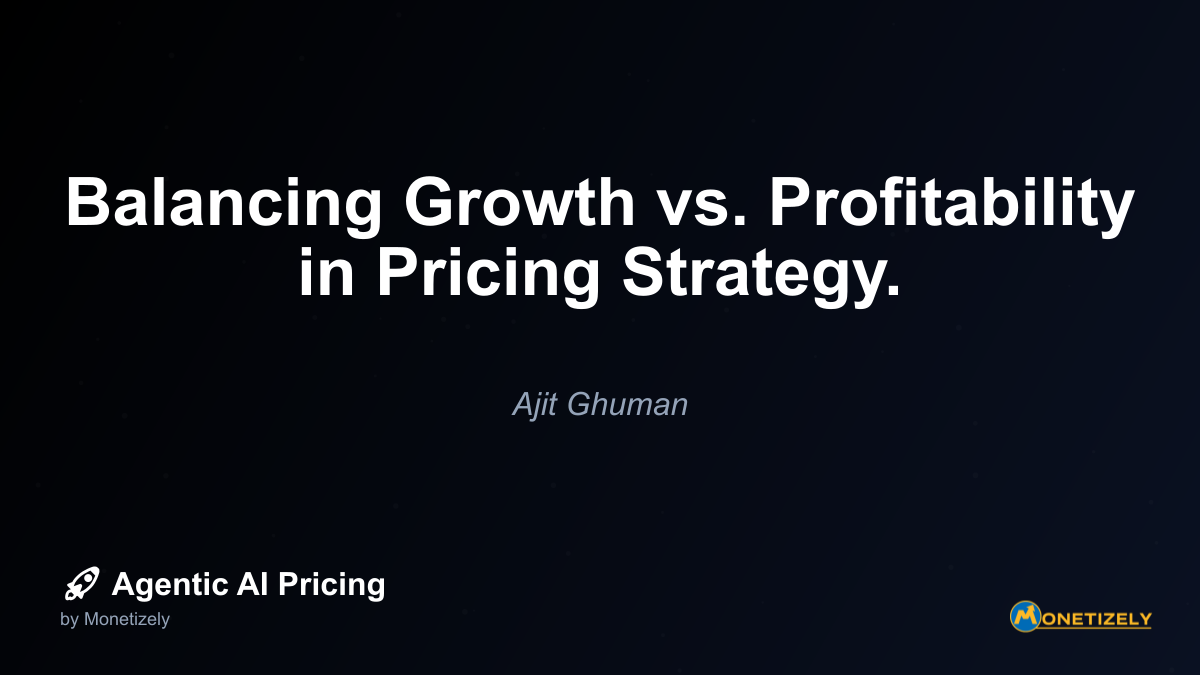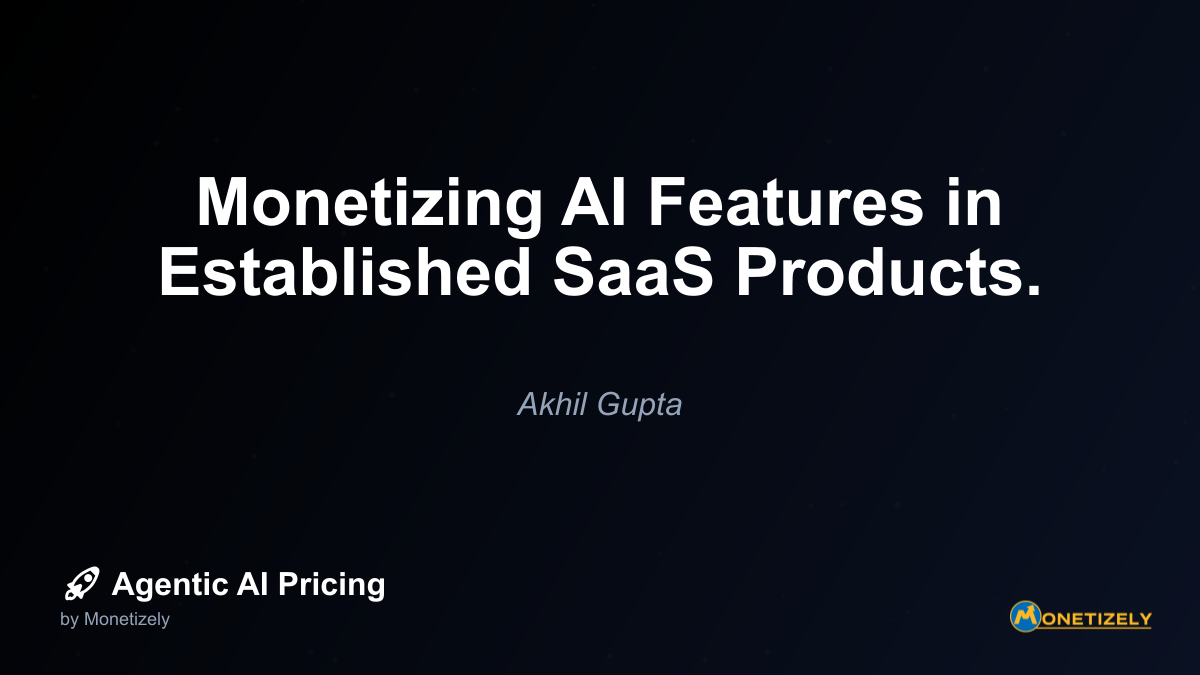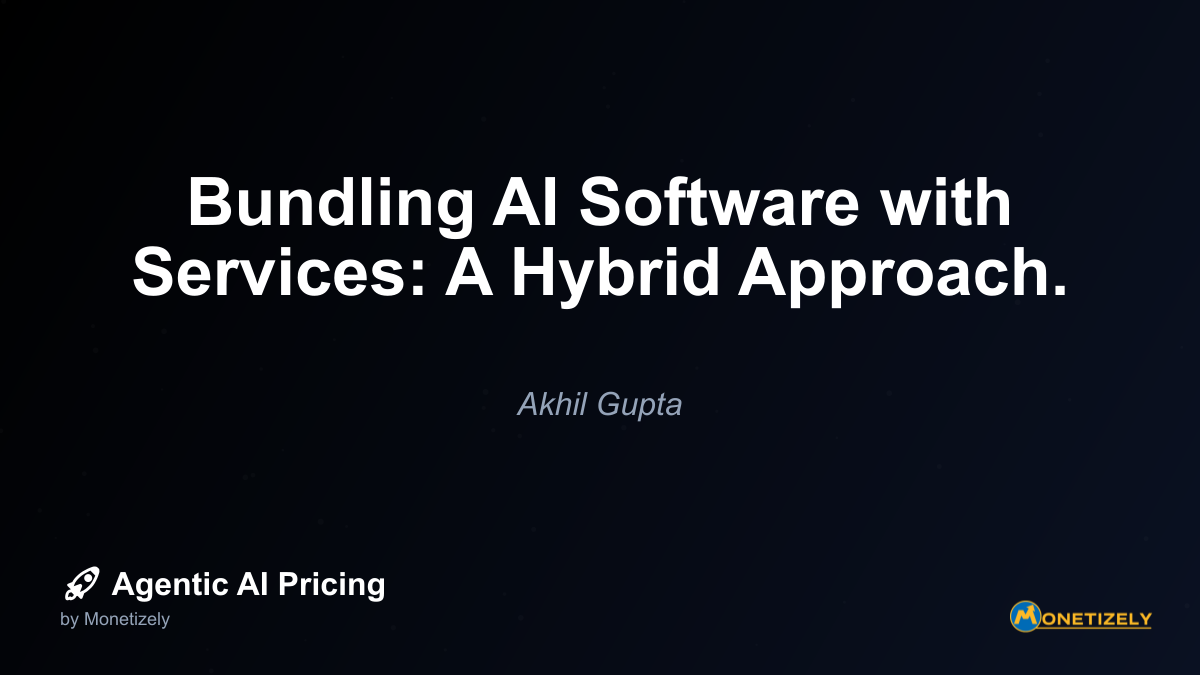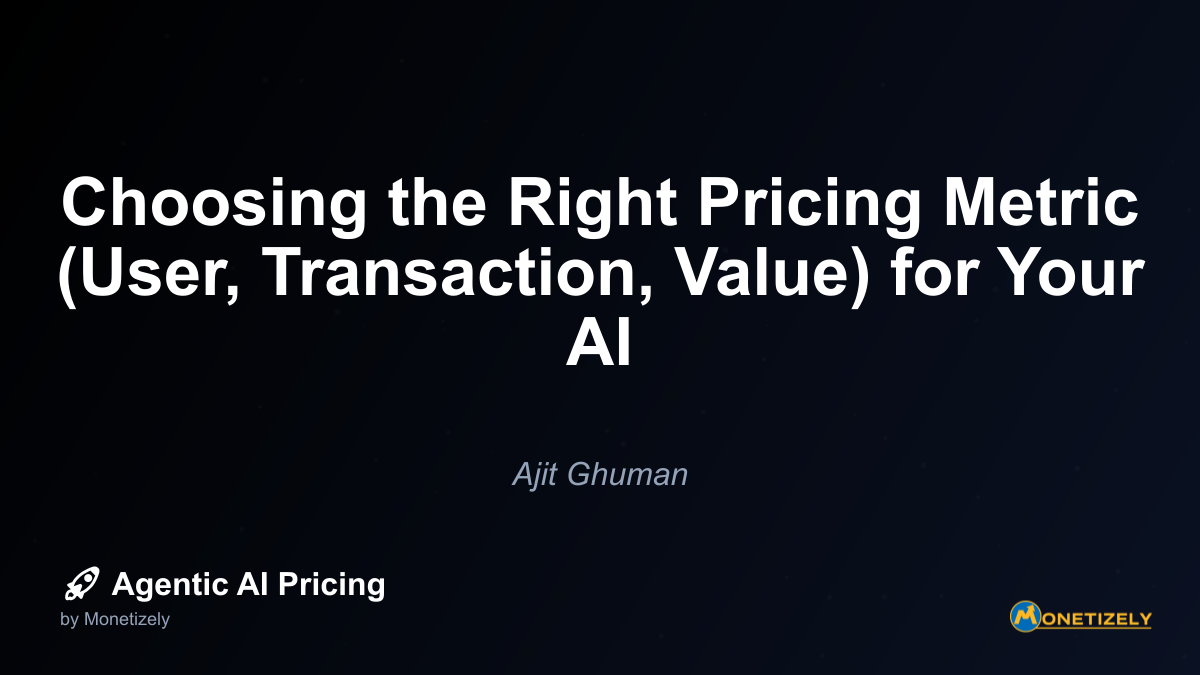· Ajit Ghuman · Strategy & Planning · 6 min read
Balancing Growth vs. Profitability in Pricing Strategy.
AI and SaaS Pricing Masterclass
Learn the art of strategic pricing directly from industry experts. Our comprehensive course provides frameworks and methodologies for optimizing your pricing strategy in the evolving AI landscape. Earn a professional certification that can be imported directly to your LinkedIn profile.

Phased Pricing Evolution
Many successful AI companies implement deliberate pricing evolution strategies that shift from growth to profitability as they mature:
- Launch phase: Aggressive pricing to drive adoption and gather data
- Expansion phase: Gradual price optimization as value proposition strengthens
- Maturity phase: Value-based pricing with segmentation to maximize profitability
- Reinvention phase: Strategic discounting for new capabilities while maintaining premium pricing for established offerings
This phased approach allows companies to align pricing with their strategic priorities at each development stage, as detailed in The Pricing Lifecycle: From Launch to Maturity to Pivot.
Geographic and Industry Segmentation
Different markets and industries have varying levels of AI maturity, competitive intensity, and willingness to pay. Strategic companies often implement:
- Aggressive pricing in emerging markets to drive adoption
- Premium pricing in mature markets to maximize profitability
- Industry-specific pricing based on value delivered and competitive dynamics
This approach enables simultaneous pursuit of growth and profitability objectives across different segments.
Metrics That Matter: Measuring the Growth-Profitability Balance
To effectively navigate the growth-profitability spectrum, AI companies should monitor several key metrics:
Growth-Oriented Metrics
- Customer Acquisition Cost (CAC): The fully loaded cost to acquire a new customer
- CAC Payback Period: The time required to recover the cost of acquiring a customer
- Net Dollar Retention (NDR): Expansion revenue from existing customers minus contraction
- Month-over-Month (MoM) Growth: The percentage increase in customers or revenue each month
- Time-to-Value: How quickly customers realize value from the AI solution
Profitability-Oriented Metrics
- Gross Margin: Revenue minus direct costs of delivering the service
- Contribution Margin: Revenue minus variable costs associated with each customer
- Customer Lifetime Value (LTV): The predicted revenue a customer will generate
- LTV/CAC Ratio: The relationship between customer value and acquisition cost
- Cash Conversion Cycle: The efficiency with which capital is deployed and recovered
Balanced Metrics
- Rule of 40: The principle that a software company’s growth rate plus profit margin should exceed 40%
- Efficiency Score: Annual recurring revenue divided by net burn rate
- Expansion Revenue Percentage: The proportion of new revenue coming from existing customers
- Magic Number: The sales efficiency metric calculated as (ARR added × 4) ÷ sales and marketing spend
- Burn Multiple: The amount of cash burned divided by net new ARR added
By tracking these metrics, companies can assess whether their current position on the growth-profitability spectrum aligns with their strategic objectives and market conditions.
Situational Analysis: When to Prioritize Growth vs. Profitability
The optimal balance between growth and profitability depends heavily on market conditions, competitive dynamics, and company-specific factors:
Scenarios Favoring Growth-Oriented Pricing
Emerging AI Categories When establishing a new AI category, aggressive pricing can accelerate adoption and establish category leadership. Companies like Jasper.ai initially offered generous pricing to establish their position in the AI content generation space before gradually optimizing for margins.
Competitive Intensity When facing well-funded competitors in a land-grab scenario, prioritizing growth through accessible pricing may be necessary to avoid being marginalized. Many conversational AI platforms adopted this approach during the initial chatbot explosion.
Network Effect Opportunities When your AI solution becomes more valuable as more users join (direct network effects) or as more data is collected (data network effects), growth-oriented pricing can accelerate value creation. This dynamic is particularly evident in AI-powered marketplaces and platforms.
Strong Capital Position Companies with substantial funding runways can afford to prioritize growth over immediate profitability, particularly when they can demonstrate improving unit economics and paths to profitability.
Scenarios Favoring Profitability-Oriented Pricing
Capital Constraints Companies with limited funding or those operating in challenging fundraising environments may need to prioritize sustainable unit economics over growth rates. This shift became evident across the AI landscape during the 2022-2023 venture capital contraction.
Commoditization Risk When underlying AI capabilities are becoming commoditized, companies often shift toward profitability-focused pricing that emphasizes their unique value proposition rather than competing on accessibility.
Computational Resource Intensity AI applications with high inference costs or substantial computational requirements often need pricing structures that ensure adequate margins to cover these expenses, particularly as usage scales.
Approaching Liquidity Events Companies preparing for IPOs or acquisition typically face increased scrutiny of their unit economics and paths to profitability, often necessitating pricing adjustments to improve financial metrics.
Implementation Strategies: Shifting Between Growth and Profitability
Companies rarely maintain a static position on the growth-profitability spectrum throughout their lifecycle. Instead, they implement deliberate transitions as their strategic priorities evolve. These transitions typically involve several key elements:
Grandfathering Existing Customers
When shifting toward profitability, companies often protect existing customer relationships by grandfathering them into legacy pricing while implementing new structures for new customers. This approach preserves goodwill while gradually improving overall margins.
Expanding Value Before Raising Prices
Before implementing price increases, successful companies typically enhance their value proposition through new features, improved performance, or additional services. This strategy maintains or improves the perceived value-to-price ratio despite higher costs.
Segmented Implementation
Rather than implementing pricing changes universally, companies often test adjustments in specific segments or markets before broader rollout. This approach provides valuable data on elasticity and customer response while limiting potential negative impacts.
Transparent Communication
When shifting pricing strategy, particularly toward profitability, clear communication about the rationale, value delivered, and implementation approach is essential for maintaining customer relationships and market perception.
Case Study: OpenAI’s Evolution from Growth to Balanced Strategy
OpenAI’s pricing evolution demonstrates the dynamic shift from growth to a more balanced approach as market conditions and strategic priorities evolved:
Initial Growth Phase (2020-2021)
- Released GPT-3 API with accessible pricing to drive developer adoption
- Prioritized ecosystem building over immediate revenue optimization
- Implemented usage-based pricing with generous free tiers
Transition Phase (2022)
- Introduced tiered pricing based on model capabilities
- Maintained accessible entry points while implementing premium pricing for advanced features
- Began optimizing pricing for computational efficiency
Balanced Approach (2023-Present)
- Implemented enterprise pricing with significant premiums for advanced capabilities, security, and support
- Maintained freemium access for developers while optimizing unit economics
- Introduced specialized pricing for high-value verticals and applications
This evolution reflects a deliberate shift from prioritizing adoption and ecosystem development toward a balanced approach that maintains accessibility while capturing value from segments with higher willingness to pay.
Conclusion: Finding Your Optimal Position
The growth versus profitability tension represents one of the most consequential strategic decisions facing AI companies. Rather than viewing these objectives as mutually exclusive, successful organizations implement nuanced approaches that evolve with their market position, competitive landscape, and financial requirements.
For early-stage AI companies, prioritizing growth through accessible pricing often makes strategic sense, particularly when network effects, data accumulation, or category establishment opportunities exist. However, this approach should be accompanied by clear metrics tracking progress toward sustainable unit economics and defined triggers for strategic shifts.
For more established AI businesses, balanced approaches that maintain growth momentum while delivering healthy margins typically deliver the most sustainable outcomes. These companies often implement segmented pricing strategies that simultaneously serve multiple objectives across different customer segments.
Ultimately, the optimal growth-profitability balance isn’t static but rather a dynamic position that evolves with changing market conditions, competitive dynamics, and strategic priorities. By implementing deliberate pricing strategies with clear metrics and transition plans, AI companies can navigate this fundamental tension to create sustainable competitive advantages and long-term value.
The most successful AI businesses don’t simply choose between growth and profitability—they strategically navigate the spectrum between these objectives, implementing deliberate shifts as their market position and strategic priorities evolve.
Co-Founder & CEO
Ajit is the author of Price To Scale, a top book on SaaS Pricing and is the Founder of Monetizely. Ajit has led and worked in pricing and product marketing at firms like Twilio, Narvar and Medallia. His work has been featured in Forbes and VentureBeat. Ajit regularly consults with software companies from Seed stage to post-IPO on pricing strategy. Ajit is also a highly-rated co-instructor for 'The Art of SaaS Pricing and Monetization' on Maven.
Pricing Strategy Audit
Let our experts analyze your current pricing strategy and identify opportunities for improvement. Our data-driven assessment will help you unlock untapped revenue potential and optimize your AI pricing approach.




